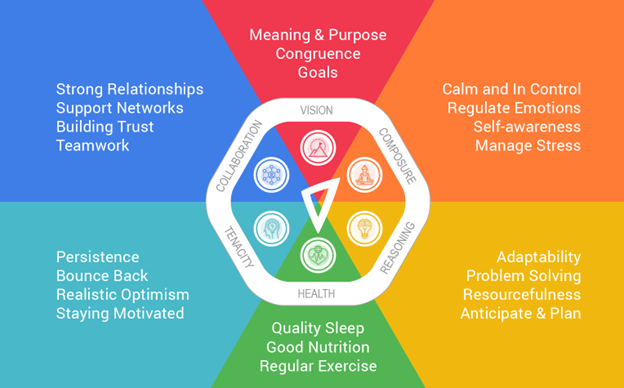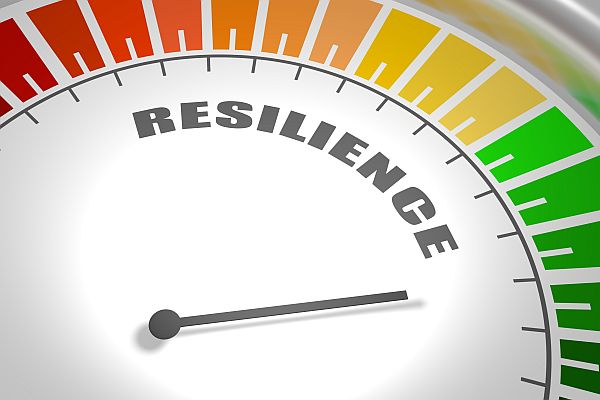
The phrase resilience has become more critical than ever in today’s society (both the covid and post-covid period). People worldwide have gone through a disrupted life cycle and unforeseen circumstances. Instead of panicking during this unexpected and challenging era, we had to remain calm and find a new approach to re-regulate our regular lifestyles and implement modifications to continue progressing and focusing on productivity. We found a new norm and framework to continue interacting to make the world a better place by creating a virtual presence. Managing our daily lives nowadays demands a significant level of resilience. In a nutshell, resilience guides us on how to bounce back after a setback and strengthens our ability.
The term “resilience” is defined as follows by Psychology Today: “Resilience is that ineffable quality that allows some people to be knocked down by life and come back stronger than ever. Rather than letting failure overcome them and drain their resolve, they find a way to rise from the ashes.”
When defining resilience, the terms “bounce back,” “grit,” “mental endurance,” “mental strength,” and “fortitude,”are sometimes used interchangeably. They’re somewhat comparable, but they’re not identical. “Bouncing back” can be a short or long-term technique of getting back up and moving forward after every disappointment, setback, or failure, instead of languishing or allowing things to weigh us down. In contrast, grit is the ability to persist in long-term “bouncing back,” no matter how intricate hurdles you encounter. Mental toughness is a personality trait in which mental endurance refers to the mental or inner strength that requires willpower, self-discipline, and perseverance, and fortitude refers to mental toughness that allows a person to confront danger, pain, or disaster with courage.
Resilience is not a personality trait that everyone inherits, yet some people are naturally more resilient than others. Resilience is mainly a set of behaviours, attitudes, and actions that can be learned and practised by everyone. When you are resilient, you are more inclined to believe that you can overcome obstacles, solve problems, and focus on opportunities to learn, improve, and grow even in the most challenging of circumstances. Resilience does not mean you are immune to negative feelings, that you can handle difficulties swiftly, or that you are resistant to change. When you are resilient, you figure out how to overcome adversity by concentrating on what you have learned and moving forward with optimism.
Everyone (including graduate students and young professionals) should set aside some time each day to practice resilience and master it. Practice and effort are the only ways to build our resilience and cope with life more readily, tolerate stress, and channel our inner strength. There are a bunch of available websites or programs that might help you practice resilience online. However, I strongly advise you to visit the website of Gemma Leigh Roberts, Chartered Psychologist and Founder (https://resilienceedge.com/10-days-of-resilience/), which will walk you through a 10-day activities program to help you develop a strong, flexible, and resilient attitude.
In a nutshell, this program will lead you on a 10-day journey of resilience. You can practice with the free workbook available on the website.
- Day-1: Refresh. This will allow you to practice a “Growth mindset.” A growth mindset can help you learn from challenging events and increase your resilience in a world full of change and uncertainty. Any encounter can teach you something that will help you get a better understanding of yourself and others.
- Day-2: Reflect. This will allow you to practice “Acceptance.” It’s easy to get caught up in the idea that you have to act right now if you’re attempting to master a new skill or make a change. However, you must be clear about the activities you will engage in and why you have selected that path. This necessitates reflection and acceptance mastery.
- Day-3: Rest. This will allow you to practice “Steering energy.” Even when you’re at your best and thriving, you still need to get some rest to help you regulate your energy and enhance your concentration on balancing actions.
- Day-4: Regenerate. This will allow you to practice “Self-belief” and enhance your problem-solving skills by acknowledging that you may not know the optimal response or next step.
- Day-5: Restore. This will allow you to practice “Intention.” Restoration is about more than just recovery; it is about figuring out what you can manage and how to succeed. It is worth noting that, while you may not be able to control everything that happens in your life, you do have some influence over your own life and destiny.
- Day-6: Reset. This will allow you to practice “Gratitude.” It will help you reset your mind to focus on pleasant events and be grateful for them, even if you’re having difficulties. It’s all about accepting your circumstance and focusing on modest steps you can take to improve them. You may be both unsettled and reassured at the same time.
- Day-7: Recharge. This will allow you to practice “Finding flow.” Finding your flow is a form of mindfulness as it allows you to disconnect from everything else and live in the present now, which is ideal if your mind has been racing or you tend to overthink things. After you have identified your strengths, you will be able to focus on how to leverage them to overcome challenges.
- Day-8: Revive. This will allow you to practice the “Support committee.” Surrounding yourself with a strong support system, which could include your parents, a partner, friends, a mentor, a coach, or coworkers, is the most effective technique for rebuilding your resilience reserves.
- Day-9: Renew. This will allow you to practice “Strategy.” Over time, resilience evolves and changes, partly related to how your emotional capacity changes throughout time. Now is the time to update your resilience plan with a solid strategy and a focus on resilience-building exercises that will help you navigate forward and create long-term resilience.
- Day-10: Recalibrate. This will allow you to practice “Feedback.” Resilience necessitates recalibrating your strategy on a regular basis, which entails changing your approach in response to feedback. It helps you establish a growth mindset, and you can learn something new as a result of the feedback. You also learn to broaden your perspectives, which is a crucial part of being resilient.

Finally, resiliency is not a skill that can be acquired overnight. It takes time, patience, practice, and devotion to a set of principles to develop and maintain unparalleled resilience.
According to Elizabeth Edwards, “Resilience is accepting your new reality, even if it’s less good than the one you had before. You can fight it, you can do nothing but scream about what you’ve lost, or you can accept that and try to put together something that’s good.”
Article Contribution: Article contributed by IMPACT Blog Editor, Naznin Akter






